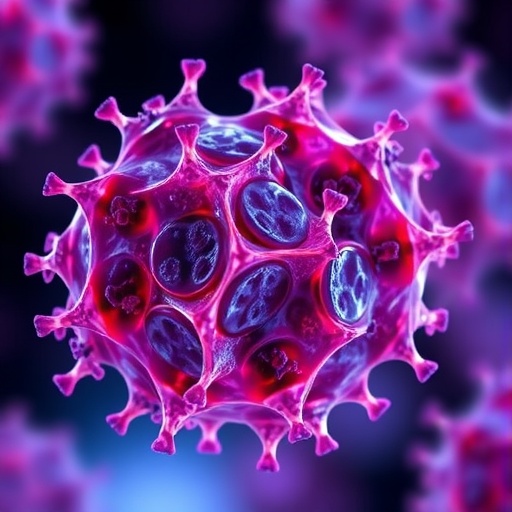In a groundbreaking study poised to revolutionize our understanding of cellular stress responses and apoptosis, researchers have unveiled the potent effects of Neocarzilin A, a natural compound demonstrating remarkable capacity to induce programmed cell death through mitochondrial disruption. Published in Cell Death Discovery, this cutting-edge research sheds light on the molecular interplay between Neocarzilin A and reticulon 4, a pivotal protein involved in endoplasmic reticulum (ER) stress regulation. This discovery holds profound implications for targeted cancer therapies and the broader field of cellular biology.
Neocarzilin A has emerged from a unique class of natural products known for their bioactive properties, prompting researchers to investigate its potential cytotoxic mechanisms. The study reveals that Neocarzilin A triggers apoptosis by specifically engaging reticulon 4-mediated pathways, which precipitate destabilization of mitochondrial function. This insight offers a dual-layered understanding of the compound’s mode of action, emphasizing its direct impact on ER stress and downstream mitochondrial integrity within the apoptotic cascade.
Reticulon 4 serves as an integral membrane protein crucial to maintaining ER morphology and function, playing a key role in the cellular response to stress. Under normal physiological conditions, reticulon 4 helps preserve ER shapes that ensure proper protein folding and cellular homeostasis. However, when challenged by Neocarzilin A, reticulon 4’s regulatory mechanisms are perturbed, leading to excessive ER stress. This escalation triggers the unfolded protein response (UPR), a cellular attempt to restore ER function that, when overwhelmed, initiates apoptotic pathways culminating in cell death.
The intersection of ER stress and mitochondrial dysfunction is a complex signaling event pivotal in determining cell fate under adverse conditions. The study meticulously details how Neocarzilin A’s targeting of reticulon 4 results in mitochondrial membrane potential loss, increased reactive oxygen species (ROS) generation, and the release of pro-apoptotic factors such as cytochrome c. These mitochondrial disturbances amplify the apoptotic signals, ensuring the irreversible commitment of the cell to death.
Experimental data from the investigation underline that Neocarzilin A’s induction of apoptosis transcends simple cytotoxicity. Instead, it initiates a programmed, highly regulated cell death pathway, making it a promising candidate for anti-cancer strategies that aim to eliminate malignant cells with minimal off-target effects. This specificity stems from reticulon 4’s differential expression patterns in various cancer cell types, offering a therapeutic window for exploiting ER stress pathways.
Detailed molecular assays reveal Neocarzilin A’s binding affinity to reticulon 4, disrupting its interaction networks within the ER membrane. Structural alterations in reticulon 4 compromise ER functions and exacerbate ER stress signals. Subsequent phosphorylation events activate UPR sensors such as PERK and IRE1, tipping the balance from survival to apoptotic signaling. These findings provide a mechanistic blueprint for Neocarzilin A’s pro-apoptotic effects and identify reticulon 4 as a viable molecular target.
Beyond its anticancer potential, the research enhances our comprehension of ER-mitochondria crosstalk, a vital axis in cellular homeostasis. By demonstrating how external compounds like Neocarzilin A can selectively modulate this axis, the study opens avenues for developing novel agents that manipulate intracellular organelle communication to restore normal cellular function or induce cell death as clinically required.
The physiological relevance of these findings was corroborated through both in vitro and in vivo models. Cancer cell lines treated with Neocarzilin A exhibited hallmark apoptotic features, including chromatin condensation and DNA fragmentation. Animal models mirrored these responses, displaying significant tumor regression linked to enhanced ER stress markers and mitochondrial disruption, highlighting translational potential from bench to bedside.
Moreover, the research distinguishes Neocarzilin A’s unique action from other known ER stress inducers, emphasizing its specificity for reticulon 4. This attribute may allow for the circumvention of resistance mechanisms commonly encountered in chemotherapy, where cancer cells adapt by modulating generic stress pathways. Targeting reticulon 4 offers a new therapeutic paradigm, circumventing conventional drug resistance and enhancing treatment efficacy.
The study also raises intriguing questions about the broader role of reticulon proteins in pathological conditions beyond cancer, including neurodegeneration and metabolic disorders. By leveraging Neocarzilin A as a molecular probe, future research could elucidate these proteins’ involvement in disease progression and identify novel intervention points for diverse medical challenges.
Importantly, the safety profile of Neocarzilin A indicates selective toxicity towards cancerous cells, sparing non-malignant counterparts. This selectivity is paramount for clinical translation, as minimizing collateral damage to healthy tissues remains a critical hurdle in cancer therapeutics. The therapeutic window defined by reticulon 4 expression patterns and ER stress responsiveness underpins this favorable safety margin.
Technological advancements, including high-resolution imaging and proteomics, were instrumental in deconvoluting the interaction landscape of Neocarzilin A and reticulon 4. These methodologies facilitated precise mapping of cellular signaling events, establishing a framework for future drug design efforts targeting the ER stress-mitochondria axis with enhanced specificity and potency.
Furthermore, the findings highlight the prospective utility of Neocarzilin A derivatives or analogs in combination therapies. Augmenting conventional chemotherapeutics with agents modulating ER stress could potentiate anti-tumor responses, overcome drug resistance, and improve patient outcomes. Clinical trials designed to evaluate such synergistic effects could herald a new era of precision oncology.
In conclusion, the elucidation of Neocarzilin A’s mechanism—centered on reticulon 4-mediated ER stress and mitochondrial disruption—not only advances fundamental cellular biology but also propels the compound into the spotlight as a promising anticancer agent. This study exemplifies how natural products continue to inspire innovative therapeutic strategies bridging molecular insight and clinical application. As research unfolds, harnessing ER stress pathways may become a cornerstone in targeted cancer treatment paradigms.
Article Title:
Neocarzilin A induces apoptosis and mitochondrial disturbance by targeting reticulon 4-mediated endoplasmic reticulum stress.
Article References:
Jauch, A.T., Sailer, J., Braun, J. et al. Neocarzilin A induces apoptosis and mitochondrial disturbance by targeting reticulon 4-mediated endoplasmic reticulum stress. Cell Death Discov. 11, 278 (2025). https://doi.org/10.1038/s41420-025-02560-3
Image Credits: AI Generated




